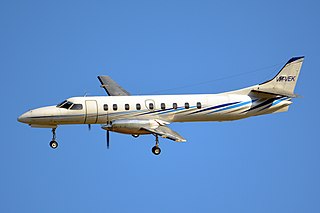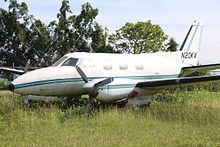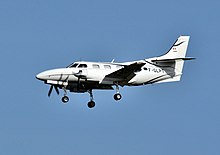
The Dassault Mirage III is a family of single/dual-seat, single-engine, fighter aircraft developed and manufactured by French aircraft company Dassault Aviation. It was the first Western European combat aircraft to exceed Mach 2 in horizontal flight, a feat which was achieved on 24 October 1958.

The Cessna 208 Caravan is a utility aircraft produced by Cessna. The project was commenced on November 20, 1981, and the prototype first flew on December 9, 1982. The production model was certified by the FAA in October 1984 and its Cargomaster freighter variant was developed for FedEx. The 4 ft (1.2 m) longer 208B Super Cargomaster first flew in 1986 and was developed into the passenger 208B Grand Caravan.

The Handley Page HP.137 Jetstream is a small twin-turboprop airliner, with a pressurised fuselage. The aircraft was designed to meet the requirements of the United States commuter and regional airline market. The design was later improved and built by British Aerospace as the BAe Jetstream 31 and BAe Jetstream 32, featuring different turboprop engines.

The Fairey Aviation Company Fairey III was a family of British reconnaissance biplanes that enjoyed a very long production and service history in both landplane and seaplane variants. First flying on 14 September 1917, examples were still in use during the Second World War.

The Embraer EMB 121 Xingu is a twin-turboprop fixed-wing aircraft built by the Brazilian aircraft manufacturer, Embraer. The design is based on the EMB 110 Bandeirante, using its wing and engine design merged with an all-new fuselage. The EMB 121 first flew on 10 October 1976.

The Cessna 441 Conquest II is the first turboprop powered aircraft designed by Cessna, and was meant to fill the gap between their jets and piston-engined aircraft. It was developed in November 1974, with the first aircraft delivered in September 1977. It is a pressurized, 8–9 passenger turbine development of the Cessna 404 Titan.

The Fairchild Swearingen Metroliner is a 19-seat, pressurized, twin-turboprop airliner first produced by Swearingen Aircraft and later by Fairchild Aircraft at a plant in San Antonio, Texas.

The Fairchild C-26 "Metroliner" is the designation for the Fairchild Swearingen Metroliner series twin turboprop aircraft in the service of the United States military. It was not officially named by the US Armed Forces, but is unofficially known by the same name as its civilian counterpart. The C-26A is the military version of the Model SA227-AC Metro III; the C-26B is the military version of the Model SA227-BC Metro III and Model SA227-DC Metro 23; and UC-26C is the military designation for the Model SA227-AT Merlin IVC.

The Piper PA-42 Cheyenne is a turboprop aircraft built by Piper Aircraft. The PA-42 Cheyenne is a larger development of the earlier PA-31T Cheyennes I and II.

The Honeywell TPE331 is a turboprop engine. It was designed in the 1950s by Garrett AiResearch, and produced since 1999 by successor Honeywell Aerospace. The engine's power output ranges from 575 to 1,650 shaft horsepower.
SyberJet Aircraft (SJA) is an American aircraft manufacturer. The company's headquarters is in Cedar City, Utah adjacent to the Cedar City Regional Airport with additional engineering offices and manufacturing, service, repair and fatigue test facilities near and on the San Antonio International Airport in San Antonio, Texas.

Merlin Express was a Part 135/121 cargo and passenger airline operating at its peak throughout the United States, North and South Caribbean, South America, Alaska, and Mexico. The airline began operations in 1983 as Sat-Air, a subsidiary of Fairchild Aircraft. UPS purchased 14 Merlin IV-C dedicated cargo aircraft from Fairchild and as part of the agreement, Fairchild agreed to provide crew and maintenance services for the aircraft. Similar contracts were signed with the United States Air Force for C-26 sales, though only maintenance add on services were included. Initially, all Merlin Express aircraft provided feeder service to United Parcel Service and were painted in UPS livery. In the ensuing years, the airline began to acquire additional aircraft from its parent Fairchild, and from the open market, incorporating freight service contracts for Federal Express, DHL, and Airborne Express. By 1998, Merlin Express was operating a fleet of approximately 30 Metro III, Merlin IV-C, and Metro II aircraft. In 1996, Merlin successfully gained certification as a passenger Part 121 carrier and operated passenger service routes in Alaska under contract for Yute Air. In 1997, Fairchild Aircraft acquired Dornier Aircraft of Germany and Merlin began preparations for the addition of D-328 aircraft to its fleet. As the airline's parent company began to confront cash problems, Merlin Express, Gen-Aero FBO Services, and other subsidiary companies of Fairchild Dornier Aerospace were sold-off in order to generate needed cash. Merlin Express was purchased by Corporate Air of Billings, Montana in 2000 and renamed "Merlin Airways". Fairchild Dornier Aerospace declared bankruptcy in 2002. Under new owners, Merlin Express' original route network was shrunk and was eventually centered on the airline's remaining hubs in Miami and San Juan, Puerto Rico. Currently based at Rafael Hernández International Airport in Aguadilla, Puerto Rico. The airline still flies to some Caribbean islands, the Turks and Caicos Islands and the Dominican Republic.

The Beechcraft Model 38P Lightning was an experimental turboprop aircraft built and tested by Beechcraft in the 1980s.

The Fokker C.IV is a 1920s Dutch two-seat reconnaissance aircraft that was designed and built by Fokker.

The Fokker F-11 was a luxury flying boat produced as an 'air yacht' in the United States in the late 1920s. Technically the aircraft was the Fokker Aircraft Corporation of America's Model 9. It was sold in North America as the Fokker F-11 and was offered in Europe as the Fokker B.IV. By the time the first six aircraft had been constructed, it was already evident that the design was not going to sell well. A few were sold, two to notable multi-millionaires; Harold Vanderbilt and Garfield Wood each purchasing one. One was bought by Air Ferries in San Francisco. The F-11A cost $40,000 but the price was slashed to $32,500 as the depression set in during 1930. The F-11 was a commercial failure.

Aeronaves TSM is an airline company based in Saltillo, Mexico. The company was founded in 1995, and operates both chartered flights and cargo flights. Their aircraft are used for cargo operations and are operated for DHL Aviation. Aeronaves TSM also provides flight training and ground school. Aeronaves TSM averages about 10,000 charter operations every year and 30 flights per day. The average fleet age of the airline is about 36 years.

On the evening of April 1, 1993, NASCAR champion Alan Kulwicki was killed in an aviation accident when the Swearingen Merlin III twin turboprop he was traveling in crashed near Blountville, Tennessee, while on approach to the nearby Tri-Cities Regional Airport. All four people on board, including two executives of the Hooters restaurant chain, were killed.

The Gorgon III – given the military designations KA3N, KU3N, CTV-N-6 and RTV-N-4 – was a rocket-powered air-to-air missile developed by the United States Navy near the end of World War II. With the end of the war, the program was changed to that of a research vehicle for missile control systems; both single and twin-rocket-powered versions were built and tested.

Flightline Flight 101 was an international flight from Barcelona El-Prat Airport in Barcelona, Spain to Ahmed Ben Bella Airport in Oran, Algeria. It crashed into the sea, probably due to a lightning strike leading to a loss of electricity.






















